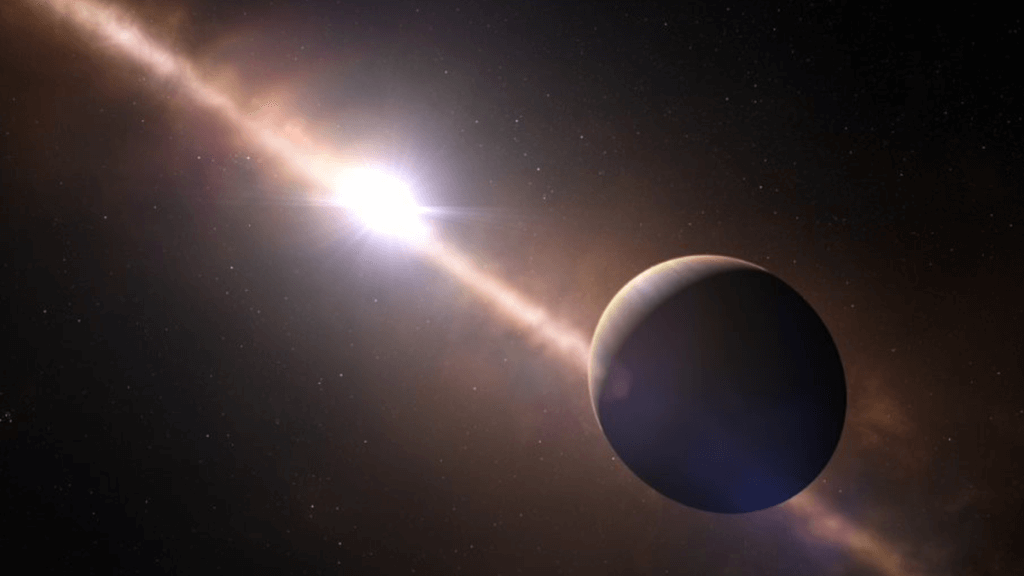
Stunning time-lapse video captures 17-year journey of exoplanet around its star (Image Credit: Space.com)
New time-lapse footage shows the 17-year-long journey of a massive alien planet around its parent star.
The extrasolar planet, or exoplanet, in focus is Beta Pictoris b, a world located around 64 light-years away with a mass close to 12 times that of Jupiter. Beta Pictoris b’s footage was created by scientists who condensed videos created with real datasets that were collected between 2003 and 2020.
But strikingly, despite being made of 17 years of hard data condensed into just 10 seconds — marking the longest time-lapse view of an exoplanet ever captured — the footage still doesn’t cover the full orbit of the massive planet around its star. Rather, it encompasses just around 75% of the journey as it takes around 23 years for total completion. Hopefully, we’ll get to catch the whole trip soon enough.
“We need another six years of data before we can see one whole orbit,” Jason Wang, research lead and an astrophysicist at Northwestern, said in a statement. “We’re almost there. Patience is key.”
Related: A Jupiter-size exoplanet formed around a tiny star. Astronomers aren’t sure how

Beta Pictoris b was first spotted in 2003. Its size and brightness actually made it easier to find than other smaller and dimmer exoplanets.
Typically, exoplanets are detected through effects they have on their parent star. For instance, they create tiny dips in their parent star’s light (as seen from Earth) while transiting the star’s face. Likewise, an exoplanet tends to produce “wobbles” in its parent star’s motion, caused by the planet gravitationally tugging on its host.
But Beta Pictoris b is one of the few exoplanets astronomers have been able to directly observe.
“It’s extremely bright,” Wang said. “That’s why it’s one of the first exoplanets to ever be discovered and directly imaged. It’s so big that it’s at the boundary of a planet and a brown dwarf, which are more massive than planets.”
The star the exoplanet orbits, Beta Pictoris, is about 1.75 times the size of the sun and almost 9 times as bright. It is also just a fraction of the age of our 4.6 billion-year-old sun, at a relatively youthful 26 million years old.
Building a smooth picture of a planet’s orbit
Wang and colleagues started tracking Beta Pictoris b several years ago, building an initial time-lapse of its orbit around its parent star that consisted of just five years of the full journey.
“A movie gives a visceral kind of appreciation for physics that you wouldn’t gain from just looking at plots on a graph,” Wang explained.
To create a longer version of the Beta Pictoris b footage, Wang turned to New Trier High School student Malachi Noel who was part of CIERA’s Research Experiences in Astronomy at CIERA for High School Students (REACH) program in the summer of 2022 and, as a REACH graduate, started working with Wang in January 2023.
Noel used artificial intelligence to create a technique that analyzed footage of Beta Pictoris b from three archival sources, Spectro-Polarimetric High-contrast Exoplanet Research (SPHERE) attached to the Very Large Telescope (VLT) in the Atacama Desert region of northern Chile, the Paranal Observatory’s NAOS+CONICA instrument (NACO) and the Gemini Observatory’s Gemini Planet Imager.
Along with a team, Noel then used an algorithm to fill gaps within the footage and create a continuous picture of the planet’s orbit. This ensured that, during the 10-second-long video, Beta Pictoris b doesn’t disconcertingly teleport from one point to another around its star.
“If we just combined the images, the video would look really jittery because we didn’t have continuous viewing of the system every day for 17 years,” Wang said. “The algorithm smooths out that jitter, so we can imagine how the planet would look if we did see it every day.”
Wang then used what’s known as “adaptive optics” to remove any blurring of the exoplanet and its star caused by the fact the footage was captured from within Earth’s atmosphere. He also used special instruments to suppress the brightness of Beta Pictoris. Left unchecked, that brightness had the effect of creating a black circle around the yellow star emoji which represents Beta Pictoris in the time-lapse video.
Although, even with these methods in place, there are still points in the footage when some glare from Beta Pictoris obscures the exoplanet. During these moments, Wang marked the exoplanet with an X so viewers can continue to track it.

Wang hopes the time-lapse footage of Beta Pictoris b gives viewers a glimpse of the inner workings of a distant planetary system that can’t be gained from graphs and equations alone.
The resultant footage also seems to have inspired Noel to think about a career rooted in studying the cosmos.
“Due to the long time range, there was a lot of diversity among the datasets, which required frequent adaptations to the image processing,” Noel said. “I really enjoyed working with the data. While it is too early to know for sure, astrophysics is definitely a career path I am seriously considering.”





